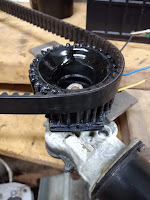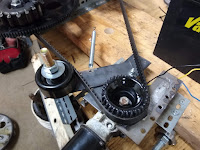May 6, 2020, Adjustments Made, To Do List Update, & 3-Speed Running Video
Work has kept me busy with little time to spend lunch hours working with the PIE, but I did take the time to do some timing adjustments. It seems strange to me that the setting is so different between the opposing spin plates & the synchronous spin plates.
I have continued with timing adjustments being made for maximum thrust without the PIE on any wheels or rollers. It is reasonably easy to see torque & thrust when sitting on a bench or table since it will attempt to push the small bench in the forward direction, even to the point of tipping it up on two legs when thrusting.
Perhaps the final settings will (once found & recorded) will help enhance other designs such as the opposing spin design originated to work in a zero gravity & zero atmosphere environment, time will tell.
I did note that different timing settings were more effective at different rpm’s. When running on Low vs. High, the timing seems to affect efficiency from retarded to advanced and the PIE becomes much more sensitive to those adjustments at the higher rpm than it is at the lowest speed.
I also took the time to measure motor rpm working on all three speeds, with the photo tachometer. I know that values would be a bit higher if the battery was connected to a charging system, but at least this is a solid base value at an average of 12.2 volts.
Speed- Value- Source Volts:
Low- 36 RPM- 12.35v
Med- 53 RPM- 12.22v
High- 66 RPM- 12.10v
With the amount of thrust (yet to have a true measurement) generated in this speed range, I can only imagine what might be possible at a modestly higher speed of 100 to 200 rpm.
Once this is a successful working prototype, I have started putting together some drawings (on paper) to put both planetary sets on a single rotating assembly, thus reducing the sprawling layout and eliminating the need for a timing belt between rotating plate assemblies. I had better update the “To Do” list.
The updated “To Do” list:
4- Explore the possibility of having sun & planet gears on both sides of the plates.
5- Mount in a motor vehicle for road testing.
As seen on the list, although small side notes could be added to some of the listed items, I am very close to real world testing on a test track & ultimately the highway.
Here is a video clip of the 3 different speeds. No timing changes were made during this run & on the highest speed, there is a significant leftward pull which will slide the front edge of the PIE sideways.

















